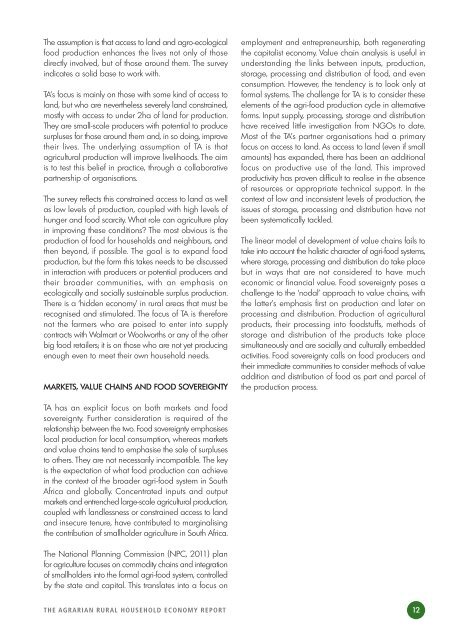THE AGRARIAN RURAL HOUSEHOLD ECONOMY
THE AGRARIAN RURAL HOUSEHOLD ECONOMY
THE AGRARIAN RURAL HOUSEHOLD ECONOMY
Create successful ePaper yourself
Turn your PDF publications into a flip-book with our unique Google optimized e-Paper software.
The assumption is that access to land and agro-ecological<br />
food production enhances the lives not only of those<br />
directly involved, but of those around them. The survey<br />
indicates a solid base to work with.<br />
TA’s focus is mainly on those with some kind of access to<br />
land, but who are nevertheless severely land constrained,<br />
mostly with access to under 2ha of land for production.<br />
They are small-scale producers with potential to produce<br />
surpluses for those around them and, in so doing, improve<br />
their lives. The underlying assumption of TA is that<br />
agricultural production will improve livelihoods. The aim<br />
is to test this belief in practice, through a collaborative<br />
partnership of organisations.<br />
The survey reflects this constrained access to land as well<br />
as low levels of production, coupled with high levels of<br />
hunger and food scarcity. What role can agriculture play<br />
in improving these conditions? The most obvious is the<br />
production of food for households and neighbours, and<br />
then beyond, if possible. The goal is to expand food<br />
production, but the form this takes needs to be discussed<br />
in interaction with producers or potential producers and<br />
their broader communities, with an emphasis on<br />
ecologically and socially sustainable surplus production.<br />
There is a ‘hidden economy’ in rural areas that must be<br />
recognised and stimulated. The focus of TA is therefore<br />
not the farmers who are poised to enter into supply<br />
contracts with Walmart or Woolworths or any of the other<br />
big food retailers; it is on those who are not yet producing<br />
enough even to meet their own household needs. .<br />
MARKETS, VALUE CHAINS AND FOOD SOVEREIGNTY<br />
TA has an explicit focus on both markets and food<br />
sovereignty. Further consideration is required of the<br />
relationship between the two. Food sovereignty emphasises<br />
local production for local consumption, whereas markets<br />
and value chains tend to emphasise the sale of surpluses<br />
to others. They are not necessarily incompatible. The key<br />
is the expectation of what food production can achieve<br />
in the context of the broader agri-food system in South<br />
Africa and globally. Concentrated inputs and output<br />
markets and entrenched large-scale agricultural production,<br />
coupled with landlessness or constrained access to land<br />
and insecure tenure, have contributed to marginalising<br />
the contribution of smallholder agriculture in South Africa.<br />
The National Planning Commission (NPC, 2011) plan<br />
for agriculture focuses on commodity chains and integration<br />
of smallholders into the formal agri-food system, controlled<br />
by the state and capital. This translates into a focus on<br />
<strong>THE</strong> <strong>AGRARIAN</strong> <strong>RURAL</strong> <strong>HOUSEHOLD</strong> <strong>ECONOMY</strong> REPORT<br />
employment and entrepreneurship, both regenerating<br />
the capitalist economy. Value chain analysis is useful in<br />
understanding the links between inputs, production,<br />
storage, processing and distribution of food, and even<br />
consumption. However, the tendency is to look only at<br />
formal systems. The challenge for TA is to consider these<br />
elements of the agri-food production cycle in alternative<br />
forms. Input supply, processing, storage and distribution<br />
have received little investigation from NGOs to date.<br />
Most of the TA’s partner organisations had a primary<br />
focus on access to land. As access to land (even if small<br />
amounts) has expanded, there has been an additional<br />
focus on productive use of the land. This improved<br />
productivity has proven difficult to realise in the absence<br />
of resources or appropriate technical support. In the<br />
context of low and inconsistent levels of production, the<br />
issues of storage, processing and distribution have not<br />
been systematically tackled.<br />
The linear model of development of value chains fails to<br />
take into account the holistic character of agri-food systems,<br />
where storage, processing and distribution do take place<br />
but in ways that are not considered to have much<br />
economic or financial value. Food sovereignty poses a<br />
challenge to the ‘nodal’ approach to value chains, with<br />
the latter’s emphasis first on production and later on<br />
processing and distribution. Production of agricultural<br />
products, their processing into foodstuffs, methods of<br />
storage and distribution of the products take place<br />
simultaneously and are socially and culturally embedded<br />
activities. Food sovereignty calls on food producers and<br />
their immediate communities to consider methods of value<br />
addition and distribution of food as part and parcel of<br />
the production process.<br />
12


